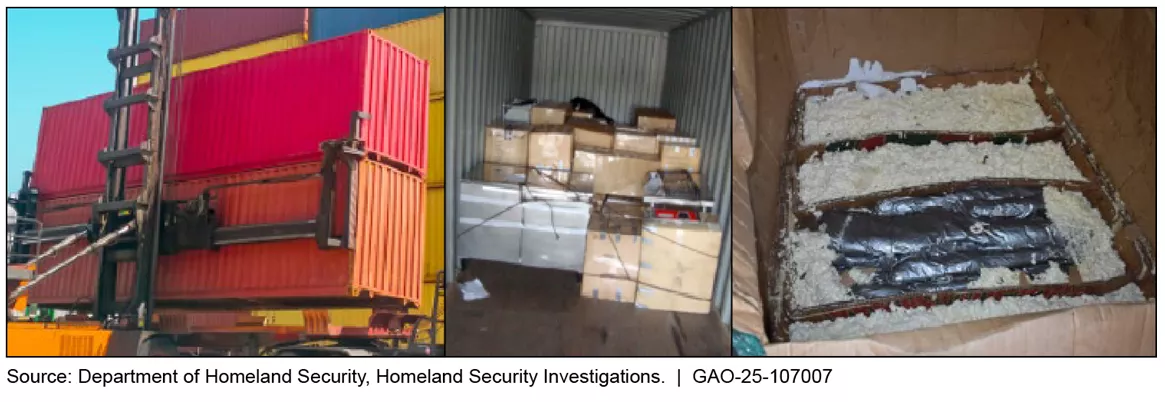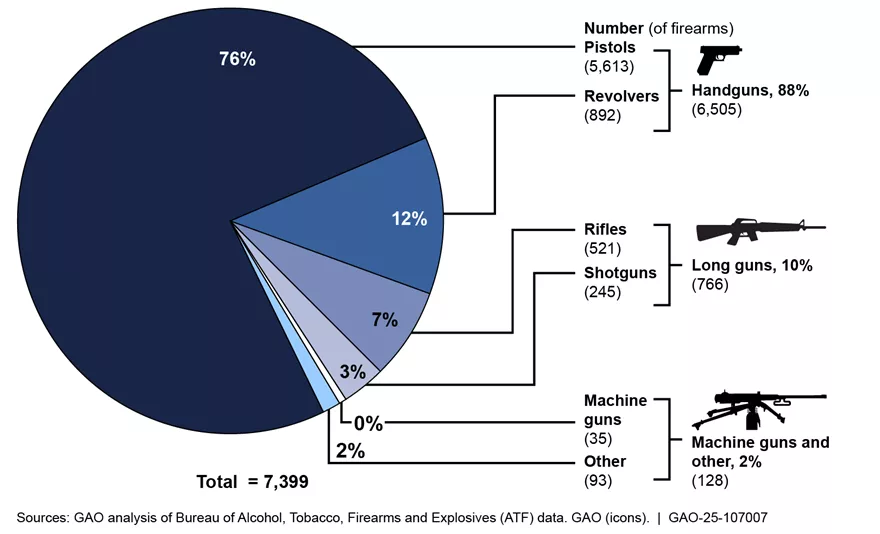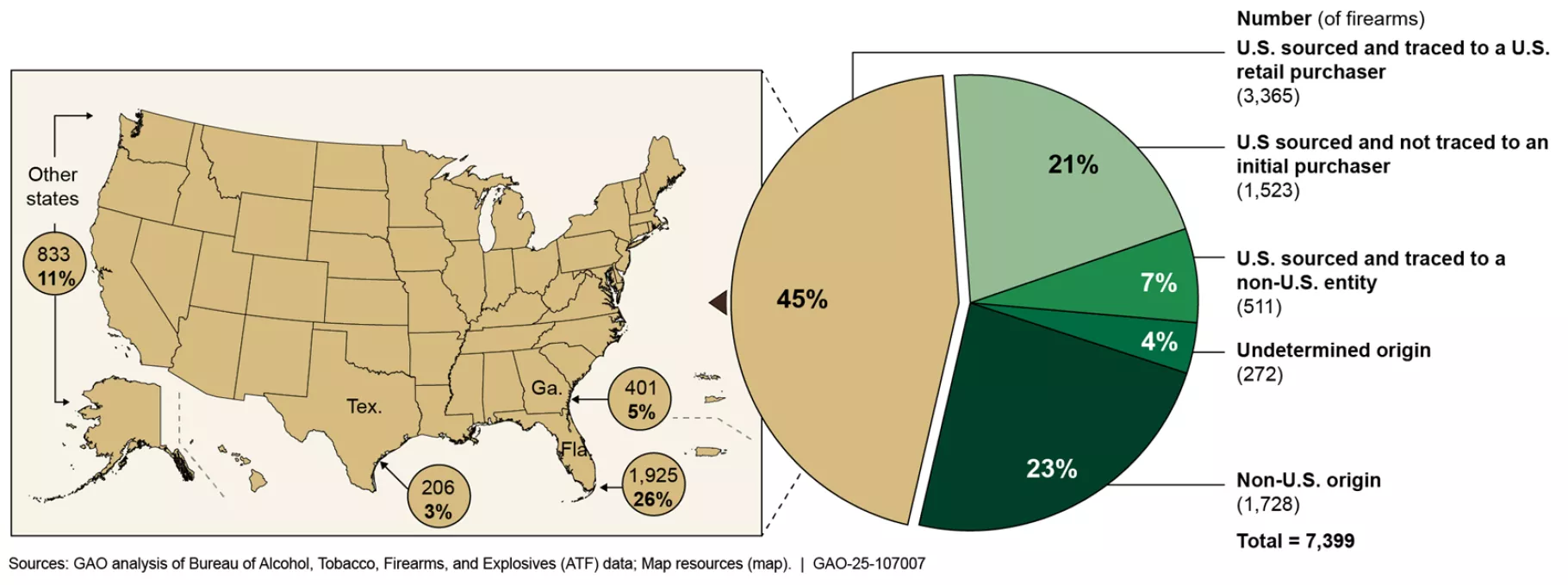High Murder Rates in the Caribbean Linked to Guns Trafficked from the United States
Gun trafficking is fueling increased violence and crime throughout the Caribbean, according to U.S. and Caribbean officials. Violent deaths in the Caribbean are nearly three times the global average. Countries like Jamaica, Haiti and Trinidad and Tobago top international lists for nations with the highest murder rates.
More than half of these murders involve guns, many of which can be traced back to the United States.
Today’s WatchBlog post looks at our new report about efforts to prevent gun trafficking from the U.S. to the Caribbean.
Example of Firearms Concealed in Shipping Containers
Image

Gun trafficking and violence in the Caribbean
Caribbean countries don’t manufacture firearms. So how are these guns getting into the islands?
There were 7,399 guns recovered from crimes and traced between 2018-2022. Of these recovered guns, 73% (or 5,399 guns) came from the United States, according to the Bureau of Alcohol, Tobacco, Firearms and Explosives (ATF). Most of these firearms were handguns.
U.S. and Caribbean officials told us that they are seeing more high-powered and increasingly lethal firearms entering the Caribbean. For example, a Department of State official working in Barbados told us they are seeing more AK-47-type weapons throughout the region. Officials from Trinidad and Tobago also said that police are collecting higher caliber bullet casings at crime scenes.
Types of Guns Recovered in the Caribbean and Traced by ATF, 2018-2022
Image

Gang members and other criminals smuggle guns through seaports on small boats or commercial shipping vessels, or on commercial airlines. Guns have been found concealed in automobiles and televisions, and household items—such as bags of rice and cereal boxes.
Guns are often purchased directly from U.S. retailors. These types of purchases account for almost half of all firearms recovered and traced in the Caribbean. Guns are also bought through illegal markets. And there is a profit to be made on illegal guns. For example, a Bahamian official said that a firearm retailing for $350 in the U.S. can be illegally sold for $1,600.
Origin of Firearms Recovered in the Caribbean, 2018-2022
Image

Efforts to prevent gun trafficking from the U.S. to the Caribbean
The U.S. currently partners with 13 Caribbean countries to stem the flow of illegal guns and other activities. These partnerships include providing resources and training to local law enforcement and others on how to look for illegal guns and trace them. For example, ATF provides local law enforcement throughout the Caribbean with access to its tracing systems and training on how to conduct firearms traces. These traces have helped local entities to identify intelligence leads, trafficking routes, and traffickers for prosecution.
There are also special operations. For example, Operation Hammerhead and Operation Rolling Thunder are collaborations to assist local Caribbean law enforcement with ongoing firearms trafficking cases and identify and disrupt illegal exports of firearms from the United States.
But despite these efforts, for various reasons U.S. agencies and Caribbean countries have sometimes struggled in effectively collaborating to prevent gun trafficking.
Political will. Some Caribbean countries and local officials are more willing than others to work with the U.S. to recover and trace firearms. In some instances, corrupt Caribbean customs officials are participating in or permitting trafficking themselves.
In Haiti, the security environment and threat of gang violence has impacted some individuals’ willingness to look for illegal guns.
Capacity. Some Caribbean countries do not have the human and technological capacity to effectively search, seize, process, and trace firearms. For example, Jamaica does not have the people and equipment needed to properly search the large number of shipments entering the country for illegal firearms.
Communication. Communicating across several U.S. federal agencies and Caribbean local governments and law enforcement is difficult. In addition to potential language barriers, there may also be a lack of trust and coordination that limits the effectiveness of antitrafficking efforts.
To help improve these efforts, we recommended that the Department of State improve how it tracks results of key efforts to combat firearms trafficking. Doing so would better enable State to measure the progress of and learn from these efforts.
Learn more about our recommendation and U.S. efforts to curb the trafficking of firearms into the Caribbean in our new report. You can also check out our work about U.S. efforts to combat gun trafficking in Mexico and Central America. Those efforts are similar to the collaborations we see in the Caribbean.
- GAO’s fact-based, nonpartisan information helps Congress and federal agencies improve government. The WatchBlog lets us contextualize GAO’s work a little more for the public. Check out more of our posts at GAO.gov/blog.
- Got a comment, question? Email us at blog@gao.gov.
GAO Contacts
Related Products

GAO's mission is to provide Congress with fact-based, nonpartisan information that can help improve federal government performance and ensure accountability for the benefit of the American people. GAO launched its WatchBlog in January, 2014, as part of its continuing effort to reach its audiences—Congress and the American people—where they are currently looking for information.
The blog format allows GAO to provide a little more context about its work than it can offer on its other social media platforms. Posts will tie GAO work to current events and the news; show how GAO’s work is affecting agencies or legislation; highlight reports, testimonies, and issue areas where GAO does work; and provide information about GAO itself, among other things.
Please send any feedback on GAO's WatchBlog to blog@gao.gov.

